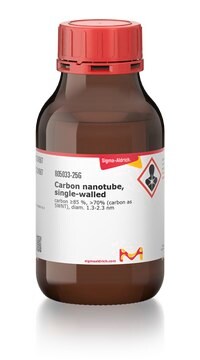755710
Kohlenstoff-Nanoröhrchen, einwandig
>70% (TGA), avg. no. of layers, 1
Synonym(e):
Einwandiges Kohlenstoffnanoröhrchen, SWCNT, SWNT
About This Item
Empfohlene Produkte
Assay
>70% (TGA)
Form
powder
Leistungsmerkmale
avg. no. of layers 1
Hersteller/Markenname
Nanocyl, Inc.
Größe L
× 3 μm , TEM
Durchschnittlicher Durchmesser
2 nm
mp (Schmelzpunkt)
3652-3697 °C (lit.)
Dichte
1.7-1.9 g/cm3 at 25 °C (lit.)
SMILES String
[C]
Suchen Sie nach ähnlichen Produkten? Aufrufen Leitfaden zum Produktvergleich
Verwandte Kategorien
Allgemeine Beschreibung
Anwendung
Angaben zur Herstellung
Rechtliche Hinweise
Lagerklassenschlüssel
11 - Combustible Solids
WGK
WGK 3
Flammpunkt (°F)
Not applicable
Flammpunkt (°C)
Not applicable
Hier finden Sie alle aktuellen Versionen:
Besitzen Sie dieses Produkt bereits?
In der Dokumentenbibliothek finden Sie die Dokumentation zu den Produkten, die Sie kürzlich erworben haben.
Kunden haben sich ebenfalls angesehen
Artikel
Single-Walled Carbon Nanotubes synthesized by the Super-Growth Method & their properties & applications, including dispersing SGCNTs, SGCNT-polymer composites & SGCNT-metal composites are discussed.
3D printing is a type of additive manufacturing that can be used to rapidly fabricate components with highly customizable geometries.
Carbon nanomaterials (CNMs), such as single-walled carbon nanotubes (SWCNTs), multi-walled carbon nanotubes (MWCNTs), and graphene (Figure 1), have diverse commercial applications including lighter and stronger composite materials, improved energy storage devices, more sensitive sensors, and smaller transistors.
Boron nitride nanotubes (BNNT) are close structural analogs of carbon nanotubes (CNT), which are high aspect ratio nanotubular material, where carbon atoms are alternately substituted by nitrogen and boron atoms.
Unser Team von Wissenschaftlern verfügt über Erfahrung in allen Forschungsbereichen einschließlich Life Science, Materialwissenschaften, chemischer Synthese, Chromatographie, Analytik und vielen mehr..
Setzen Sie sich mit dem technischen Dienst in Verbindung.



